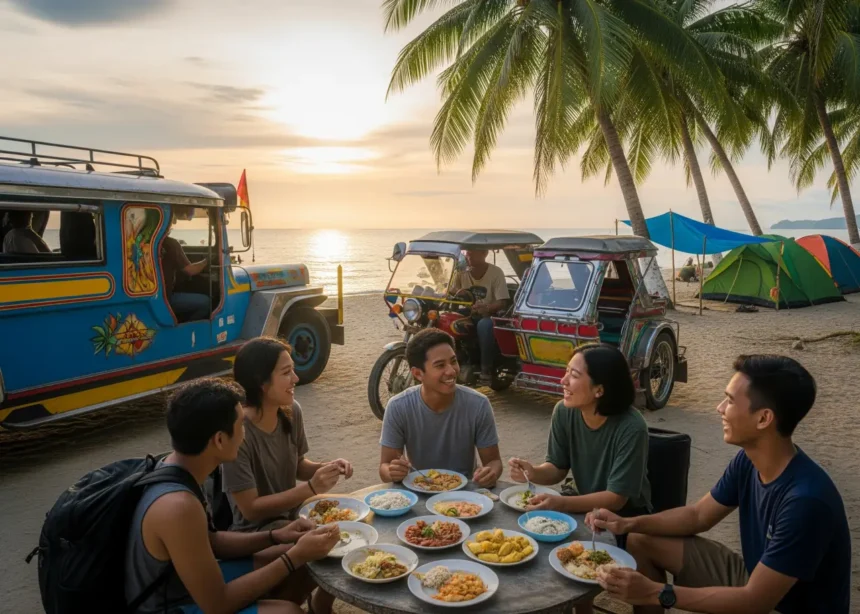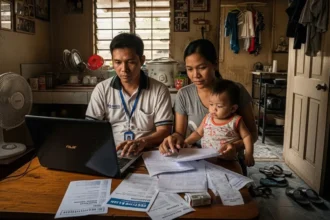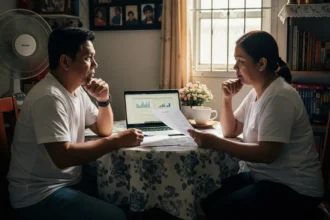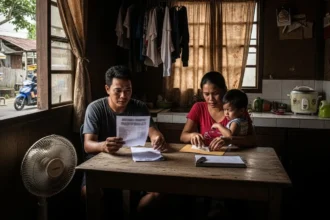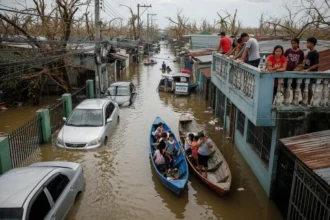🥾 Yes, You Can Travel the Philippines on ₱1,000 a Day
Many Filipinos think traveling is only for the rich. But the truth is, with a bit of diskarte and smart planning, you can explore beaches, mountains, and cities all over the Philippines without going broke. A budget of ₱1,000 per day might sound impossible, pero kaya if you know the right hacks.
- 🥾 Yes, You Can Travel the Philippines on ₱1,000 a Day
- 🚌 Transportation Hacks: Getting Around Without Breaking the Bank
- 🍲 Food Hacks: Sulit Meals on a Budget
- 🛌 Accommodation Hacks: Where to Sleep Cheaply
- 🎉 Activity & Experience Hacks: Fun Without Emptying Your Wallet
- 💸 Money & Planning Hacks: Stretch Every Peso
- 🛠️ Miscellaneous Hacks: Extra Tricks to Save More
- 🧾 Sample ₱1,000/Day Travel Budget
- 📚 Frequently Asked Questions
- ✨ Traveling Isn’t About Luxury, It’s About Stories
I’ve done it myself – sleeping in dorms, eating at carinderias, and hopping on jeepneys. And trust me, the memories felt richer than any luxury trip. Here are 30 tried-and-tested tipid travel hacks that can stretch your peso and still give you amazing adventures.
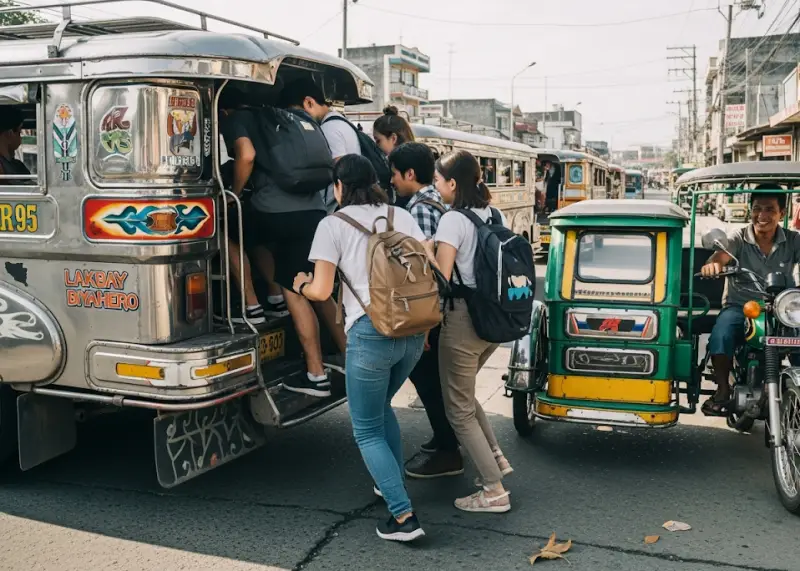
🚌 Transportation Hacks: Getting Around Without Breaking the Bank
-
Book Buses and Vans Instead of Flights
Flying feels fast, but your wallet will feel it too. Domestic flights can eat up half your daily budget in one go. If you’re not in a rush, buses and vans are the way to go.-
Example: Manila → Baguio by bus costs around ₱500 one way vs. a ₱2,000+ flight.
-
Overnight buses are double wins: you save on accommodation and wake up at your destination.
-
Pro tip: Victory Liner, DLTB, and Genesis buses have decent seats, some with Wi-Fi and charging ports.
-
-
Use Promo Fares (Piso Sales)
Piso fares are the golden ticket for budget travelers. Airlines like Cebu Pacific, AirAsia, and PAL run promos several times a year.-
Sign up for newsletters or follow them on Facebook/Twitter for alerts.
-
Be ready with your travel dates, IDs, and payment details – piso seats sell out in minutes.
-
Booking months in advance feels like a hassle, but when you’re flying to Boracay for under ₱500, it’s worth it.
-
-
Ride Jeepneys and Tricycles Like a Local
Skip the Grab rides unless absolutely necessary. Public transport is not only cheaper but also part of the local experience.-
Jeepneys: ₱12 minimum fare; routes can take you across the city for under ₱30.
-
Tricycles: usually ₱20–₱50, but always ask the rate first to avoid “tourist pricing.”
-
If you’re in tourist-heavy areas like El Nido or Siargao, you can even rent a tricycle for the day (₱300–₱500) – cheaper than multiple short rides.
-
-
Try Point-to-Point (P2P) Buses
In cities like Manila or Cebu, P2P buses are clean, air-conditioned, and surprisingly cheap.-
Example: NAIA Terminal 3 → Makati only ₱150 (vs. a ₱400 taxi).
-
Bonus: You skip traffic since P2P buses use designated stops and sometimes faster routes.
-
-
Share Rides With Fellow Travelers
In rural areas where transport is scarce, sharing costs helps.-
Example: Splitting a tricycle to a waterfall with 2–3 backpackers can cut fares by half.
-
Join hostel group chats or Facebook backpacker groups to find ride buddies.
-
| Mode of Transport | Average Cost | When to Use |
|---|---|---|
| Jeepney | ₱12 – ₱25 | Short trips in cities/towns |
| Tricycle | ₱20 – ₱80 | Within barangays/provinces |
| Bus/Van | ₱100 – ₱600 | City-to-city travel |
| Promo Flight | ₱1 – ₱1,500 | Long-distance, if booked early |
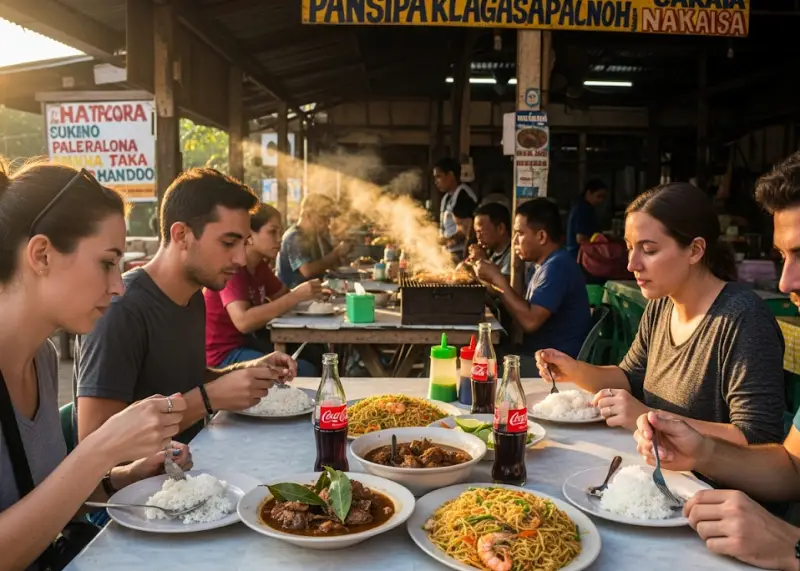
🍲 Food Hacks: Sulit Meals on a Budget
-
Eat at Carinderias
Carinderias and turo-turo stalls are the backpacker’s best friend. You can eat like a king without spending like one.-
A plate of rice + ulam (adobo, giniling, fried fish) costs only ₱50–₱80. Add gulay or soup, and you’re still under ₱100.
-
Compare that to restos charging ₱250–₱400 for the same meal.
-
Bonus: You’ll taste real lutong bahay flavors that big restaurants can’t match.
-
Tip: Ask locals which carinderia is “masarap.” Crowded ones usually mean fresh, fast turnover of food.
-
-
Bring a Reusable Water Bottle
Buying bottled water adds up: ₱30 x 3 bottles daily = ₱90/day. That’s already a meal!-
Many hostels, cafés, and even bus terminals offer free or cheap refills.
-
Plus, you’ll cut down on plastic waste – good for your wallet and the planet.
-
Tip: Some provinces have safe-to-drink tap water. Always ask first. If unsure, refill from purified dispensers (₱5–₱10 per liter).
-
-
Try Street Food for Snacks
Street food is the secret weapon of the budget traveler. For under ₱20–₱30, you can grab something tasty that keeps you energized while exploring.-
Fishballs, kwek-kwek, kikiam: ₱5–₱20 per stick.
-
Banana cue, turon, camote cue: ₱15–₱20, perfect for merienda.
-
Taho: ₱10–₱20 for a sweet protein boost in the morning.
-
Tip: Go for stalls with long lines – it means the food is fresh and safe.
-
-
Take Advantage of Unlimited Rice Spots
Some eateries offer “unli rice” meals starting at ₱99. Perfect if you’ve had a long hike or swim and need to fuel up without overspending.-
Mang Inasal is the classic example: chicken meal + unli rice for under ₱200.
-
-
Shop at Local Markets
Public markets (palengke) sell fruits, snacks, and fresh meals way cheaper than tourist restaurants.-
Example: A kilo of mangosteen in Davao is ₱80 vs. ₱250 in Manila malls.
-
Grab fruits for breakfast or snacks to avoid spending big on cafés.
-

🛌 Accommodation Hacks: Where to Sleep Cheaply
-
Stay in Hostels and Dorms
Hostels are the go-to for budget travelers. They’re cheap, social, and usually in central locations.-
Dorm beds range from ₱300–₱600 per night, depending on the city.
-
You get the basics: bed, fan or AC, shared bathroom, and often free Wi-Fi.
-
The real perk: meeting fellow travelers. You’ll swap tips, join group tours, or even share rides to split costs.
-
Tip: Bring earplugs and a sleep mask – dorm life can get noisy.
-
-
Use Apps Like Agoda, Booking, or Airbnb
Don’t just walk in and hope for the best. Apps can save you time and pesos.-
Sort by “Lowest Price + Reviews” to filter out sketchy places.
-
Watch out for freebies like breakfast, towels, or Wi-Fi – these add value and save you money.
-
Airbnb is great for group travel: split a ₱1,200 apartment among 3 people and you’re paying only ₱400 each.
-
Pro tip: Book directly with the hostel after finding them online – sometimes they’ll give a discount since there’s no booking fee.
-
-
Consider Overnight Travel
Two-in-one hack: save on both accommodation and time.-
Overnight buses, ferries, or vans double as your “hotel on wheels.”
-
Example: Manila → Sagada overnight bus costs about ₱1,000, but you also save on one night’s stay.
-
Ferries (like Batangas → Caticlan for Boracay) have economy bunks for as low as ₱800–₱1,200 – basically a floating dorm bed.
-
Tip: Bring a jacket or scarf, as buses and ferries crank up the AC.
-
-
Try Couchsurfing or Staying with Friends
If you’re open to it, Couchsurfing (a free stay exchange app) connects you with locals offering a couch or spare bed.
-
It’s not just free lodging – you get local insight and sometimes even home-cooked meals.
-
Got friends or relatives in the province? Don’t be shy to crash – just be respectful and bring a small pasalubong as thanks.
-
Camp or Pitch a Tent
If you’re into the outdoors, camping can cut costs big time.
-
Many beach resorts or mountain parks allow tents for ₱150–₱300 instead of renting a room.
-
Some backpackers even carry compact hammocks with mosquito nets for ultra-budget stays.
-
Tip: Always ask permission before setting up, and make sure it’s a safe spot.
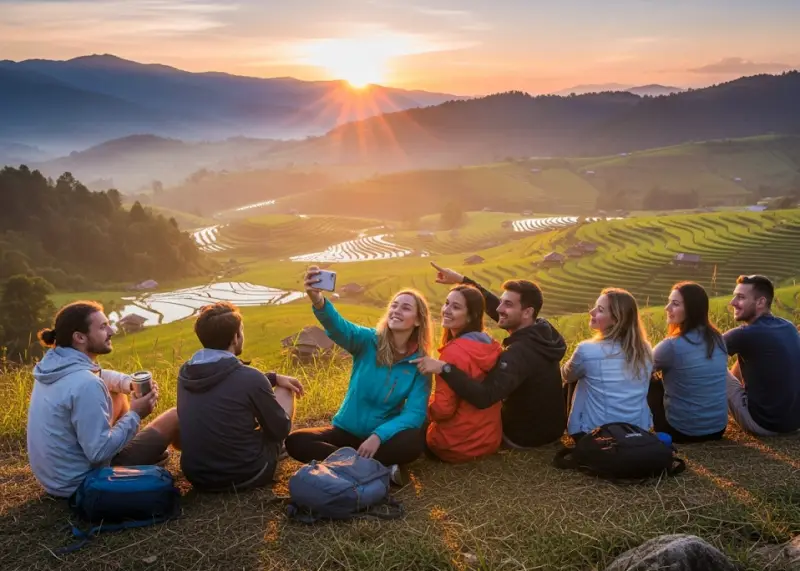
🎉 Activity & Experience Hacks: Fun Without Emptying Your Wallet
-
Look for Free Attractions
Not all adventures come with a price tag. Many of the best spots in the Philippines are free to enjoy.
-
Beaches: Most public beaches don’t charge entrance fees (like Liwliwa in Zambales or Dahican in Mati).
-
Nature spots: Town plazas, waterfalls, and street murals are open for everyone.
-
Churches and heritage sites: Exploring centuries-old structures like Vigan Cathedral or San Agustin Church is free.
-
Tip: Ask locals what they recommend – they’ll often point you to hidden gems that aren’t in guidebooks.
-
DIY Tours Instead of Packages
Tour agencies can be convenient, but they often mark up prices. Going DIY lets you control your budget.
-
Example: In Bohol, a countryside tour package is around ₱2,500, but if you rent a motorbike for ₱400/day, you can visit Chocolate Hills, Tarsier Sanctuary, and more on your own.
-
Join with fellow backpackers to share jeepney/tricycle hires instead of paying solo.
-
Bonus: You can stay longer in places you actually enjoy instead of rushing through a fixed itinerary.
-
Join Free Walking Tours or Local Festivals
Some cities offer free walking tours (just tip your guide if you can). These are great for learning history and meeting other travelers.
-
In Manila, groups sometimes host heritage walks in Intramuros.
-
Local fiestas are cultural goldmines – you’ll see parades, dances, and sometimes even get free food. Fiesta = free street party!
-
Student, Senior, or Local Discounts
Don’t forget the perks of IDs.
-
Students and seniors can get 20% discounts on tickets, transport, and some attractions.
-
Locals (Filipino residents) usually pay less than foreigner rates in tourist spots – so always bring a valid ID.
-
Go for “Bundle Passes”
Some destinations sell packages that cover multiple attractions at a lower cost.
-
Example: Puerto Princesa Underground River tour already includes van, permits, and lunch for about ₱1,500 (if booked in a group). Buying separately would cost way more.
-
Tip: Always compare if DIY is cheaper than a bundled deal – it depends on the place.
-
Sunrise and Sunset are Always Free
Whether you’re on a mountain summit or sitting by the shore, nothing beats a Filipino sunrise or sunset. It’s 100% free, 100% unforgettable.
-
Sunset: Best by the beach (Boracay, Manila Bay, Siargao Cloud 9).
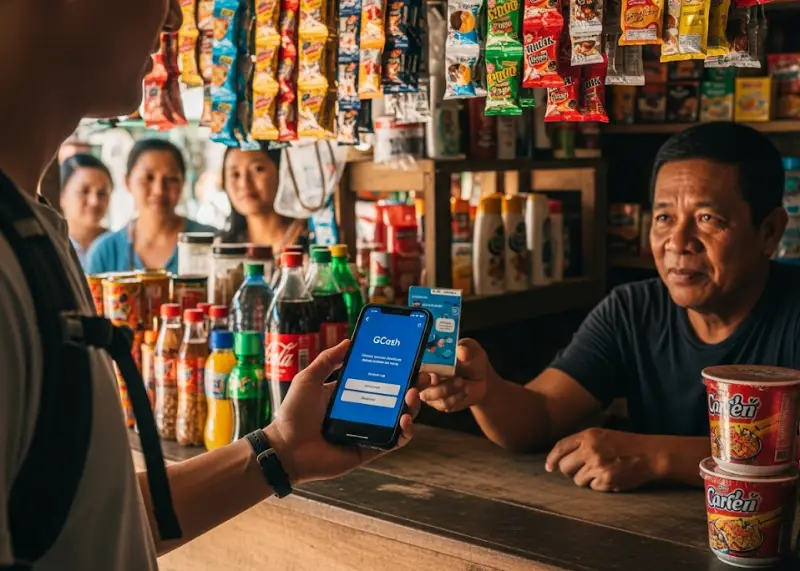
💸 Money & Planning Hacks: Stretch Every Peso
-
Use GCash and Maya
ATM withdrawal fees in the Philippines can hurt – most banks charge around ₱250 per withdrawal if you’re using a non-partner card. Skip the fees by going digital.
-
GCash and Maya let you pay via QR codes in cafés, markets, tricycle terminals, and even sari-sari stores in many towns.
-
You can also transfer money to friends instantly, which is great if you’re splitting bills.
-
Pro tip: Always carry a little cash though – some remote barangays are still cash-only, and ATMs can run out of money.
-
Set a Daily Budget and Stick to It
It’s easy to overspend when you’re hyped on adventure, so discipline is key.
-
Try the envelope method: Put ₱1,000 cash per day in small envelopes. Once it’s gone, it’s gone.
-
If you’re more techy, use apps like Trail Wallet or just a simple notes app to log expenses.
-
This keeps you mindful of where your money goes (spoiler: most of it on food and tricycle rides 😂).
-
Travel Off-Season
Timing matters. Traveling during off-peak months (June–September) can slash your costs significantly.
-
Hotels, tours, and even flights drop prices by 30–40% since there are fewer tourists.
-
Bonus: You’ll enjoy destinations without the heavy crowds. Imagine Boracay with empty beaches or Baguio without insane traffic.
-
Just be mindful of weather: pack a raincoat, waterproof bag cover, and always check local forecasts. Rain showers come and go quickly, so it’s usually not a dealbreaker.
-
Book in Advance, But Stay Flexible
Early bookings get you the cheapest flights and hostels, but don’t lock yourself in too tight.
-
Tip: Secure the “big costs” (flights, first 1–2 nights stay), then leave room for spontaneity. Sometimes locals will recommend cheaper, better stays once you arrive.
-
Always Have an Emergency Fund
Set aside at least ₱2,000–₱3,000 as your “untouchable” backup.
-
This saves you if you miss a bus, get sick, or suddenly need to book a last-minute ride.
-
Keep it separate from your daily envelopes or GCash balance so you’re not tempted to spend it.

🛠️ Miscellaneous Hacks: Extra Tricks to Save More
-
Get a Local SIM Card
Staying connected helps you navigate, book rides, and find cheap eats nearby.
-
Globe and Smart both offer tourist SIM packages starting at ₱299 for 21–30 days with data.
-
Data is crucial for using Google Maps, Grab, and messaging fellow travelers.
-
Pro tip: Buy at official airport kiosks or malls to avoid getting overcharged by street vendors.
-
Bring Your Own Essentials
Small expenses add up if you keep buying them on the road.
-
Pack items like a reusable tote bag, quick-dry towel, toiletries, and power bank.
-
Buying soap, toothpaste, or even sunscreen in tourist areas can be 2–3x pricier than in your local supermarket.
-
Use Public Wi-Fi Wisely
Cafés, malls, and even some jeepney terminals offer free Wi-Fi.
-
Download offline maps and playlists whenever you get a stable connection to save on data.
-
Just avoid logging into sensitive accounts on public networks for security.
-
Talk to Locals
Some of the best budget tips don’t come from blogs or guides but from people who actually live there.
-
Locals know the cheapest eateries, hidden transport routes, and free attractions.
-
Even just asking a tricycle driver “Saan po yung mura pero masarap na kainan?” can save you hundreds of pesos.
🧾 Sample ₱1,000/Day Travel Budget
| Category | Cost (per day) |
|---|---|
| Food (3 meals + snacks) | ₱250 – ₱300 |
| Transport (local) | ₱100 – ₱200 |
| Accommodation | ₱300 – ₱500 |
| Entrance fees / Activities | ₱100 – ₱200 |
| Misc. | ₱50 – ₱100 |
| Total | ₱800 – ₱1,000 |
📌 See? It works if you prioritize the essentials and skip the unnecessary luxuries.
📚 Frequently Asked Questions
Is ₱1,000/day really enough to travel in the Philippines?
Yes, if you stick to hostels, carinderias, and public transport. Tourist traps and luxury resorts will blow your budget.
Which destinations are best for tipid travel?
Baguio, La Union, Cebu City, Dumaguete, and Zambales are affordable and accessible. Palawan and Boracay can be done on a budget if you skip luxury add-ons.
Can families travel on ₱1,000/day each?
Yes, but kids may need more comfort (private rooms, proper meals). Expect to spend closer to ₱1,500 per adult if with family.
Is street food safe for travelers?
Generally yes, if cooked fresh and hot. Always check for clean stalls.
How do you save money on island-hopping?
Travel in groups and share boat rentals. Or join public tours instead of private charters.
What’s the cheapest province for budget travel?
Negros Oriental (Dumaguete, Apo Island) and Baguio/La Union are favorites for budget-conscious travelers.
Can foreigners survive on ₱1,000/day?
Yes, but they might prefer mid-range stays. ₱1,000/day is doable for locals; foreigners often spend closer to ₱1,500/day.
How far in advance should I book for cheap rates?
Flights: 3–6 months before. Hostels: 1–2 weeks before is usually fine.
What if I overspend one day?
Balance it out the next day by cutting extras. The envelope method works best.
✨ Traveling Isn’t About Luxury, It’s About Stories
I still remember riding a bus to Sagada with just ₱3,000 in my wallet for three days. I slept in a homestay, ate ₱70 carinderia meals, and trekked to Echo Valley with new friends I met along the way. It wasn’t glamorous, but it was unforgettable.
That’s the beauty of tipid travel in the Philippines – it teaches you creativity, patience, and appreciation for the simple joys. Whether it’s a ₱20 turon by the beach or a ₱12 jeepney ride to a hidden spot, every small moment feels big.
So don’t wait until you’re “rich enough” to travel. With ₱1,000/day, the Philippines is already open for you. Pack light, bring your diskarte, and collect kwentos that money can’t buy.



